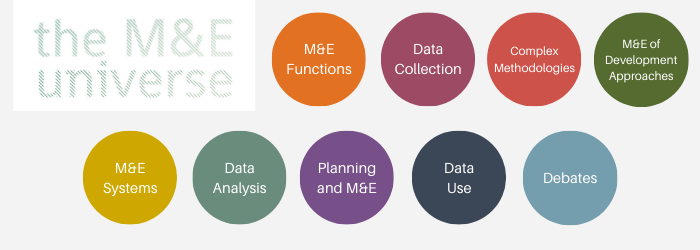The M&E Universe is a free, online resource developed by INTRAC to support development practitioners involved in monitoring and evaluation (M&E). It consists of a series of short papers (typically 2-6 pages) on different subjects related to M&E. To begin exploring the Universe right away, use the button below. To find out more, read on.
The M&E Universe is designed for M&E practitioners with different levels of experience and expertise in M&E, from those new to M&E who want an entry level into the subject to experienced practitioners wanting to broaden their knowledge. Initial contact with the platform will provide people with a starting point for understanding different aspects of M&E and how they link to each other. More experienced practitioners can browse the platform to identify more advanced subjects of interest, such as sampling methods, different forms of evaluation, organisational M&E systems and complex methodologies for data collection and analysis.
The M&E Universe is divided into nine discrete areas of interest:
- Planning M&E: Planning is at the heart of the universe and provides an entry point for those who are relatively new to the world of M&E.
- Data Collection: This section covers basic data collection methods such as interviews, focus group discussions, observation, as well as related issues such as sampling and the use of ICT in data collection
- Complex Methods of Data Collection and Analysis: More complex methods used to collect and analyse data, such as: contribution analysis, most significant change, experimental methods, organisational Assessment tools, qualitative comparative analysis and others.
- Data Analysis: Methods and approaches for analysing M&E data, including both quantitative and qualitative analysis.
- Data Use: This section deals with the different uses of M&E information, including learning, accountability, management and communications, and advice on how these uses affect the design of M&E systems.
- M&E Functions: This section covers monitoring, evaluation, reviews, impact assessments and research, and explains how these interrelate; the evaluation section contains sub-sections on the different kinds of evaluations commonly in use.
- M&E systems: Advice and information on designing and developing M&E systems, including the practicalities of basic M&E systems as well as developing M&E systems for more complex situations.
- M&E debates: Brief introductions to some of the main debates surrounding M&E – both past and present.
- M&E of development approaches – Advice on planning, monitoring and evaluating different programming approaches such as advocacy, capacity building and mobilisation.
The Universe is designed to be compatible with most web browsers, including Chrome, Safari, Firefox and Microsoft Edge. It will also work with Internet Explorer 11, but not earlier versions of Internet Explorer. The universe is compatible with tablet and mobile browsers, but is best viewed on larger screens.
There are nine areas in the Map, each containing a central ‘bubble’ and linked ‘bubbles’. Clicking on the central bubble or any of the linked bubbles will open up a brief paragraph describing the associated paper, along with a download link.
Clicking on the link will take you to a .pdf version of the paper. At the end of each paper are links to further papers and external resources (where available), and a home button to return to the Map.
Whilst navigating the Map, any of the following can be done at any time:
- The search button at the top left of the screen (magnifying glass) can be used to search for terms within papers.
- Zooming in and out: the ‘+’ button allows you to zoom into an area of the Map and the ‘-‘ button allows you to zoom out again. The ‘zoomfit’ button ‘’ allows you to restore the full Map at any point.
The M&E Universe is different from other online resources:
- it focuses on monitoring as well as evaluation, and is aimed particularly at staff working on internal M&E within organisations, rather than outside experts;
- it includes areas of M&E such as M&E systems, which are not widely covered elsewhere;
- it is comprehensive – people can explore what they don’t know about M&E, as well as find what they were looking for;
- it is practitioner-focused, with content developed by M&E practitioners for M&E practitioners;
- it is flexible and adaptable – more papers will be added, and we plan to review and update papers to response to trends and debates.
The M&E Universe is provided freely by INTRAC as part of our mission to strengthen civil society organisations, to help them do what they do better. For that reason, we would love for you to share these resources widely, so as many development practitioners as possible can benefit from them. Also, we would love to hear how you have made use of the M&E Universe. To send us your questions, comments, and experiences of using the Universe, please use the Contact Us page.
